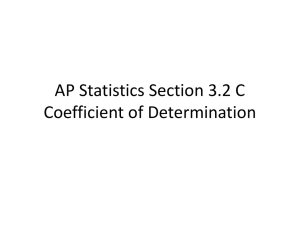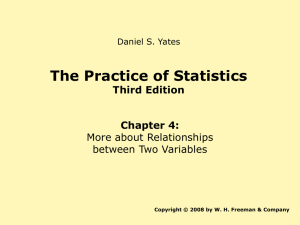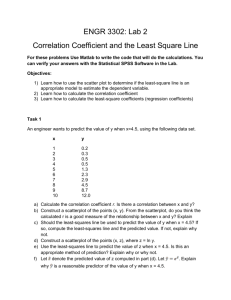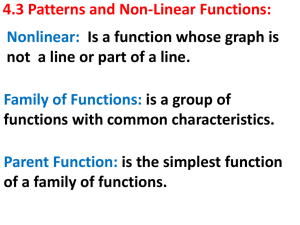File - Glorybeth Becker
advertisement
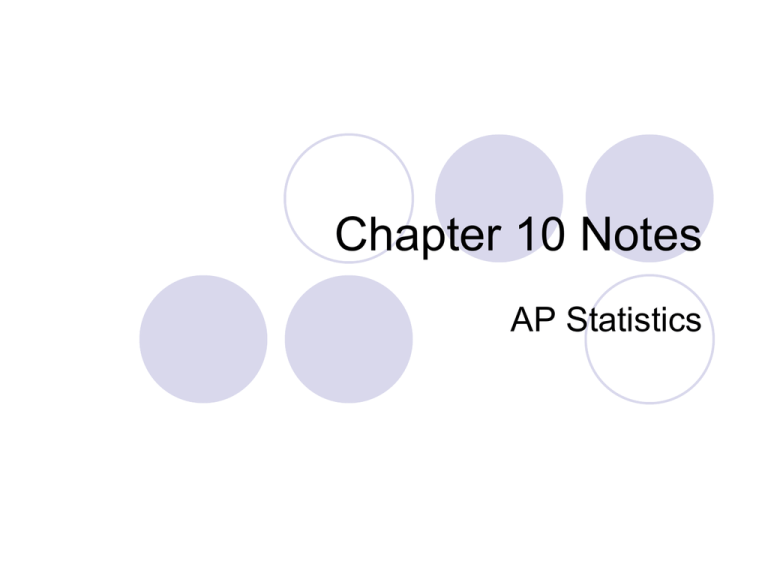
Chapter 10 Notes AP Statistics Re-expressing Data We cannot use a linear model unless the relationship between the two variables is linear. If the relationship is nonlinear (which we can verify by examining the residual plot) we can try re-expressing the data. Then we can fit and use a simple linear model. To re-express the data, we perform some mathematical operation on the data values such as taking the reciprocal, taking the logarithm , or taking the square root . For example, consider the relationship between the weight of cars and their fuel efficiency (miles per gallon). What do the scatterplot and residual plots reveal? a curved pattern – therefore, linear model is not appropriate. If we take the reciprocal of the y-values, we get the following scatterplot and residual plot. What do these plots reveal? That the relationship between weight and gal/100 mi (reciprocal of mpg) is linear. There are several reasons we may want to reexpress our data: To make the distribution of a variable more symmetric. To make the spreads of several groups more alike. To make the form of a scatterplot more linear. To make the scatter in a scatterplot more evenly spread . Re-expressing Data Using Logarithms An equation of the form y = a + bx is used to model linear data. The process of transforming nonlinear data into linear data is called linearization. In order to linearize certain types of data we use properties of logarithms. PROPERTIES OF LOGARITHMS: 1. log ab a 2. log b 3. log x p Case 1: Consider the following set of Linear Data representing an account balance as a function of time: Describe the pattern of change… balance increases by $480 per 48 months The relationship between x and y is linear if, for equal increments of x, we add a fixed increment to y. Case 2: Consider the following set of Nonlinear Data representing an account balance as a function of time: Describe the pattern of change… balance increases by 61.22% or multiplied by 1.6122 The relationship between x and y is exponential if, for equal increments of x, we multiply a fixed increment by y. This increment is called the common ratio. We want to find the best fitting model to represent our data. For the linear data, we use least-squares regression to find the best fitting line. For this nonlinear data, the best fitting model would be an exponential curve. PROBLEM: We cannot use least-squares regression for the nonlinear data because least-squares regression depends upon correlation, which only measures the strength of linear relationships. SOLUTION: We transform the nonlinear data into linear data, and then use leastsquares regression to determine the best fitting line for the transformed data. Finally, do a reverse transformation to turn the linear equation back into a nonlinear equation which will model our original nonlinear data. Linearizing Exponential Functions: (We want to write an exponential function of the form y a b x as a function of the form y a bx ). (Hint: Take the log of both sides. ( x , y are variables and a , b are constants) y a b x This is in the general form y = a + bx, which is linear. So, the graph of (var1, var2) is linear. This means the graph of (x, log y) is linear. CONCLUSIONS: 1. If the graph of log y vs. x is linear, then the graph of y vs. x is exponential. 2. If the graph of y vs. x is exponential, then the graph of log y vs. x is linear. Once we have linearized our data, we can use least-squares regression on the transformed data to find the best fitting linear model. PRACTICE: Linearize the data for Case 2 and find the least-squares regression line for the transformed data. (Hint: Put x in L1, y in L2, and log y in L3). Then do a LinReg L1, L3.) Then, do a reverse transformation to turn the linear equation back into an exponential equation. x (mos.) 0 48 96 144 192 240 y ($) 100 161.22 259.93 419.06 675.62 1089.30 Compare this to the equation the calculator gives when performing exponential regression on the Case 2 data. (Hint: Do an ExpReg (stat, calc, 0:ExpReg) L1, L2.) Linearizing Power Functions: (We want to write a power function of the form y ax as a function of the form y a bx ). (Hint: Take the log of both sides.) ( x , y are variables and a , b are constants) b y ax b This is in the general form y = a + bx, which is linear. So, the graph of (var1, var2) is linear. This means the graph of log x, log y is linear. Case 3: Consider the following set of Nonlinear Data representing the average length and weight at different ages for Atlantic Ocean rockfish: x: age (years) 4 8 12 16 20 y: weight (grams) 48 192 432 768 1200 PRACTICE: Linearize the data for Case 3 and find the least-squares regression line for the transformed data. (Hint: Put x in L1, y in L2, log x in L3, and log y in L4. Then do a linReg L3, L4.) Then, do a reverse transformation to turn the linear equation back into a power equation. Compare this to the equation the calculator gives when performing power regression on the Case 3 data. (Hint: Do a PwrReg (Stat, Calc, A: PwrReg) L1, L2.)



